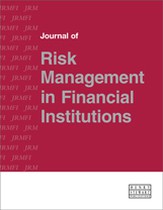Managing performance using a dual measure framework
Abstract
One of the deficiencies highlighted by the recent financial crisis in value-at-risk (VaR) based capital requirements was a lack of focus on more near-term sensitivities to market shocks. Many financial institutions were still able to meet their capital requirements when they received government bailouts. Sensitivity — particularly in earnings — to risk drivers can have devastating impacts on financial institutions at much lower confidence intervals than those used to calculate capital requirements. Market participants and other counterparties can quickly lose confidence in institutions that are still relatively well capitalised but whose earnings have been eroded by market loss events. This paper introduces a dual risk metric framework to manage the tail of a loss distribution and addresses sensitivity to movements in market variables at lower confidence intervals. While the risk-adjusted return on capital (RAROC) provides a valuable performance measurement metric and tail risk measures such as economic capital are useful inputs in this metric, these extreme tail measures are not informative of the impact of more moderate, one in 10- or 20-year loss events, on the expected income. A financial institution needs to manage these near-term risks in addition to tail risk driving its capital needs. The latter can be managed through an earnings-at-risk (EaR) framework and the former through an economic capital framework. This paper examines how to use these metrics simultaneously to allow a financial institution to set its risk appetite and effectively manage both moderate and extreme risk exposures. The traditional RAROC metric is extended to also accommodate the EaR appetite. This dual measure framework is demonstrated for a monoline company and a multiline company. The paper then discusses how this limit framework can be used in a dynamic fashion for risk-adjusted return optimisation.
The full article is available to subscribers to the journal.
Author's Biography
Bogie Ozdemir is a Vice President in Sun Life Financial Group. He is responsible for economic capital and is building out its capabilities for Solvency II/Own Risk and Solvency Assessment (ORSA) and model validation. Bogie was a Vice President in the BMO Financial Group responsible for economic capital, stress testing and Basel analytics, and jointly responsible for the Internal Capital Adequacy Assessment Process (ICAAP). Previously he was a Vice President in S&P’s Risk Solutions, globally responsible for engineering and implementing new solutions and business development. He has co-authored various papers and a book on Basel II implementation.
Evren Cubukgil is Assistant Vice President of ORSA and Internal Models at Sun Life Financial in Toronto Canada. He focuses on Strategic Risk Management, and Risk and Capital optimisation to enhance ROE. Evren has previously worked on Solvency II ORSA and Operational Risk Modeling in the United Kingdom, on Credit Economic Capital and Stress testing models for ICAAP in Canada and holds a D.Phil in Economics from University of Oxford.
Huaxing Xia is Director of Market Risk Analytics group at Bank of America Merrill Lynch in New York, providing analytic support for market risk and credit specific risk models. Prior to this, Huaxing has worked for Sun Life Financial, Swiss Re, and Canadian Imperial Bank of Commerce, responsible for model validation and analytics, credit trading quantitative support, and debt specific risk modeling. Huaxing holds a Ph.D. in Applied Mathematics from the University of Alberta, Canada.
Citation
Ozdemir, Bogie, Cubukgil, Evren and Xia, Huaxing (2014, June 1). Managing performance using a dual measure framework. In the Journal of Risk Management in Financial Institutions, Volume 7, Issue 3. https://doi.org/10.69554/XOOG6655.Publications LLP
